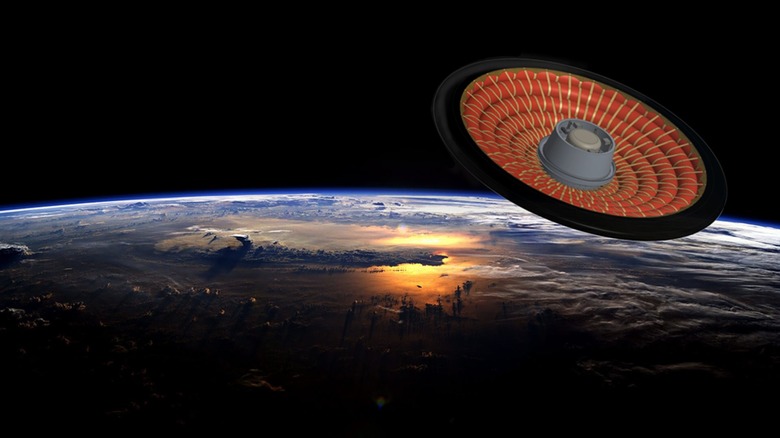NASA's Inflatable Heat Shield Could Help Land Heavier Rovers On Mars
There are a lot of reasons that it's challenging to land on Mars. From difficulties with predicting the weather, to the communications delay means that landing has to be done autonomously, as well as the exact nature of the calculations needed to touch down on the surface without going too fast — there are plenty of potential difficulties to landing a mission successfully.
But one of the biggest challenges is to do with slowing down. When a spacecraft is barreling through space, it travels at tremendously high speeds, but it also needs to slow down considerably in order to land safely. The atmosphere of Mars is thin, at just 1% the density of Earth's atmosphere, so although you can use parachutes to slow down, these aren't as effective as they would be on Earth. Traveling through the atmosphere, even if it is thin, creates a tremendous amount of heat, which could damage a rover or lander. That's why missions like the NASA Perseverance rover are protected by a heat shield as they come in to land.
Current heat shields are rigid, meaning they have to be able to fit inside a rocket. That limits their size, which means there's limitations on how heavy a payload they can protect. If we want to be able to land heavier payloads like larger and more advanced rovers on Mars, we'll need a different type of heat shield.
NASA recently tested out a new heat shield concept called Low-Earth Orbit Flight Test of an Inflatable Decelerator, or LOFTID, which could make landing these heavier payloads on Mars possible.
The LOFTID demonstration
On November 10, 2022, a United Launch Alliance Atlas V rocket launched a NASA weather satellite called JPSS-2 for the National Oceanic and Atmospheric Administration. In addition to the satellite, the rocket was also carrying a test of the inflatable LOFTID heat shield. Instead of being rigid, the heat shield can travel in a compact form and then be deployed to a much larger size once it is in space.
The heat shield, also called an "aeroshell," was deployed in space to travel through Earth's atmosphere to see if it could survive re-entry. When it entered the atmosphere it was traveling at 18,000 miles per hour, and it slowed to under 80 miles per hour before its parachutes deployed. The heat shield then splashed down into the Pacific Ocean, from where it could be collected so that engineers could analyze it.
The results from the test are promising, according to NASA. "[E]arly indications show that the demonstration was successful," NASA writes. "In addition to achieving its primary objective of surviving the intense dynamic pressure and heating of re-entry, it appears that the aft side of the heat shield – opposite LOFTID's nose – was well protected from the re-entry environment."
It will take several more months for complete testing to be performed, but the early results suggest that the system can be used to land heavier payloads. As well as landing rovers on Mars, such a heat shield could also be used on other planets like Venus or on moons like Titan, as well as being used on Earth.
